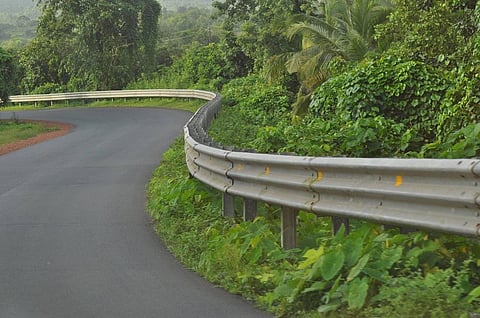
- Home
- न्यूजग्राम
- NewsGram USA
- India
- World
- Politics
- Entertainment
- Culture
- Lifestyle
- Economy
- Sports
- Sp. Coverage
- Misc.
- NewsGram Exclusive
- Jobs / Internships

By NewsGram Staff Writer
At a public meeting convened by the Mumbai Waterfronts Centre (MWC) on June 24, the Dutch Consul in Mumbai, Arend Gouw, said that the city's ambitious, expensive Rs.11,300-crore coastal road, if not planned properly, would "homogenize" the coast.
He then corrected this to "destroy".
On June 5, Dutch Prime Minister Mark Rutte met Maharashtra Chief Minister Devendra Fadnavis and announced Dutch technical assistance for the 34.6-km-long road – 53 years after it was first planned – to be built at a cost of Rs 322 crore per km, or only Rs. 28 crore per km less than Mumbai's future Metro lines.
Although the consultants presented the detailed project report (DPR) on the road on Mumbai's western seafront this February, the municipal corporation only made it public on June 24.
This was after Union Environment Minister Prakash Javadekar cleared the road, connecting Nariman Point in south Mumbai to Kandivali in the northern suburbs, on June 8, subject to two conditions:
One, to reclaim as little land for the project; such reclamation was halted in 1974 after protests by environmentalists.
Second, to retain the current building restrictions under the Coastal Regulation Zone (CRZ). These prohibit construction within 500 metres of the high-tide line.
Since the road will be constructed some 100-200 metres off the coast, there was the danger that the high-tide line would have been pushed back by that much, permitting construction on some of India's most expensive real estate.
Activists attended a meeting convened by the MWC on July 3 to list their objections to the project, originally mooted by Los Angeles-based planners in 1962.
The DPR reveals the lack of institutional support for a coherent mobility policy, according to Rishi Aggarwal from the Observer Research Foundation.
It also cites how due to the global economic downturn, Mumbai's population growth has slowed perceptibly. Between 2001 and 2011, the city only grew by 500,000 people.
It shows that the growth in car traffic will peak at 3 percent per annum between 2015 and 2019, slowing down to 0.3 percent between 2040 and 2043, an average of only 1.7 percent in these 28 years.
It estimated a maximum of 34,090 cars per day in 2014 through the existing Bandra-Worli Sea Link (BWSL), which was built in 2009 and will be connected to the road. This dropped to 11,378 cars at its southernmost section at Nariman Point.
In 2044, it estimated at most 61,749 cars a day at BWSL, dropping to 27,616 at Nariman Point.
Nariman Point and south Mumbai are losing their clout as the old central business district. They are ceding ground to the Bandra-Kurla Complex, where real estate prices are higher. Other centres have opened up in the suburbs too for IT and other industries.
Apart from the declining importance of Nariman Point, motorists are reluctant to pay Rs.60 one way or Rs.90 return and prefer to use the old inland route, which takes more time.
If one took the interest on the Rs.11,300 crores spent on the new road – which will go up when finally ready in three or more years – and added maintenance costs, the one-way toll from Kandivali to Nariman Point should be around Rs.400, according to an expert. Few people would pay this.
The alignment of the road is also questionable, according to Shweta Wagh, on the faculty of Kamala Raheja college. There will be an undersea 5-km-long tunnel from Nariman Point across the Marine Drive bay through Malabar Hill to Nepean Sea Road.
When Marine Drive already exists as a reclaimed road, why not align the road to follow its contours, asks Wagh.
At Dadar Prabhadevi beach, Dutch technology has been used to replenish the sandy beach and prevent further erosion. With the construction envisaged for the road, further damage to the coastal topography can't be ruled out.
According to an earlier official report, 186 hectares will be reclaimed, but no buildings will be permitted on them.
This will obstruct the operations of fisherfolk, according to Rajesh Mangela of the Maharashtra Machimar Kruti Sangh. In the past, reclamation at Nariman Point and BWSL has similarly affected their livelihood.
Under the original scheme for the road, proposed by the architect Hafeez Contractor, there would have been an even 100-metre-wide entirely reclaimed swathe to serve as the highway. This would have privatised public space.
If the Metro is built into the road, it will increase reclamation "drastically", according to an official who worked on the road. Officials have also mentioned creating parking areas along the road.
While the DPR route shows the road ending abruptly in Madh island, which will be connected to Greater Mumbai by a bridge, the narrow roads running through these northern villages will be widened even more than the coastal road. This will destroy the ambience of these areas, which serve as weekend getaways for Mumbaikars.
The DPR admits that the project will not be financially viable on a Build, Operate and Transfer basis. However, it does not specify how much it should charge as toll to recover capital and recurring costs.
(With inputs from IANS)
